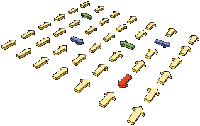Laterality and Directionality Problems
in Children

Laterality refers to motor awareness of the two sides of the body, while directionality refers to the ability to know right from left, up from down, forward from backward, etc.
The child who has a laterality problem has not yet internalized the knowledge that the body has two sides. One manifestation frequently noted is called midline crossing problem, that is, the child is unable to continue a motor act like writing without switching hands at the point which faces his/her middle. To illustrate, the left-hander writes up to the middle of the page and changes hands or moves to the next line leaving the right half blank, while the right-hander writes from the middle leaving the left half blank.
A child with a directionality problem has difficulty dealing with directions of objects in relation to self, such as "to my right," "to my left," "above me," "below me," etc. Such a child has difficulty following directions on paper-pencil tasks such as "write your name in the top right-hand corner," "draw a line under the word ______," and the like. He may also confuse letters like b and d, numbers like 17 and 71, or write backward, from right to left, the letters appearing like ordinary writing seen in a mirror.
|
Edublox programs develop foundational learning skills such as concentration, laterality, directionality, sequencing, visual and auditory memory, imagination, logical reasoning, concept of numbers, fine and gross motor coordination, sensory-motor integration, etc.
|
|